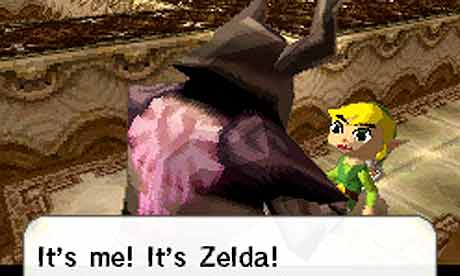This latest instalment in the much-loved Zelda series ditches the nautical setting of Phantom Hourglass, its immediate predecessor, in favour of a locomotive theme, with much of the game spent piloting a steam train along the tracks of the title.
However, aside from this new mode of transport, there's not all that much else in the way of innovation, yet it still manages to be one of the best DS games of the year. Evil doings are once again afoot in the land of Hyrule, and it's up to you to guide heroic young Hylian Link through a cell-shaded world of castles, market towns, forests and dungeons, in order to thwart the baddies, rescue the princess, restore peace to the land, and all the other usual hero business. Built on the same engine as Phantom Hourglass, the gameplay is very similar, involving a combination of exploration, combat and puzzle-solving through which the hero, Link, is controlled with the DS stylus, with various jabs at the touch screen eliciting different sword swipes, steps and somersaults. While all this feels very familiar, there are a few new additions to the mix.
This time around Link is accompanied by the spirit of Princess Zelda after her body is "stolen" by a villainous courtier. For much of the game Zelda's role is much like that of Navi in Ocarina of Time on the N64, unobtrusively following Link around in sprite form and offering the occasional word of advice. However, at several points she can be used as a playable character when she possesses one of the armour-clad Phantom Guardians that inhabit the dungeons. In this form she can enter areas that are inaccessible to Link, help fight enemies, or distract other Phantom Guardians while Link sneaks around behind them. While the train travel element initially feels like a step backwards from the free-roaming possibilities of Phantom Hourglass's sea-faring, the restrictions of travelling along rails are put to good use, and travelling around Hyrule soon becomes an engaging challenge.
Spirit Tracks gets a lot of use out of the DS's microphone; with a "whirlwind" weapon equipped, gently blowing down the mic can disperse clouds of poison gas, shift items round and help defeat enemies. Early on in the game Link gets hold of Spirit Pipes, colour-coded pan pipes used to perform spells, which are also operated with the mic. Both of these features work very well, but adult gamers might feel a touch self-conscious when called on to repeatedly blow on their DS while out in public. While not a huge leap forward from Phantom Hourglass, Spirit Tracks is still brimming with invention, and has all the wit and charm we've come to expect from Zelda titles. It's certainly as good as Phantom Hourglass, and quite possibly better – there's nothing as tediously repetitive as the earlier game's Temple of the Ocean King, and overall it moves along at a much swifter pace, but not at the expense of depth. It's certainly more than deserving of a place in every discerning DS owner's games collection.

Comments (…)
Sign in or create your Guardian account to join the discussion